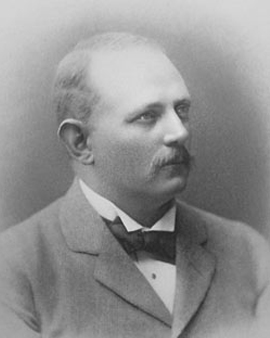Peter Henry Emerson was actually a doctor and scientist. He bought his first camera in 1882, and from then on it was a faithful companion. Together with his friend, the ornithologist A.T. Evans, he went on excursions on which the first photographs were taken. With the same seriousness with which he studied physics, chemistry and medicine, Emerson threw himself into the study of photography at Cambridge University. The works, taken during an anthropological study of fishermen and farmers in the east of England, showed how Emerson understood photography: it should reproduce what the human eye sees in nature. A sharp main subject, the rest blurred into blur.
His style of photography was met with interest, but also rejection. In the Victorian era, in the mid-19th century, the emphasis was on emotive, romantic staging. Elaborate costumes, made-up models, opulent backdrops served as subjects. So very different from Emerson's work. He regarded this type of photography with a certain disdain. Nature was the core of his photographs. Unadulterated, genuine, direct, without any pathos. The way man saw his surroundings. He was aware that he polarized. But in lectures, books and articles he vehemently represented his opinion. He could afford to do so. Emerson was born into a wealthy family in Cuba. His father was American and owned sugar and coffee plantations on the island. His mother, Jane Harris Biling, was English. After his father's death, Emerson moved to England and enjoyed a privileged education at a private boys' school in Cranleigh. He completed his medical studies with honors in 1880.
Emerson developed into a classic Victorian gentleman. He played billiards, founded a rowing club, and was an active member of the Royal Meteorological Society. He wrote his first book in 1881,and married Edith Amy Ainsworth, an Englishwoman, that same year. She was the daughter of a surgeon. With her he had five children. The first book was followed by more than thirteen others and countless articles. Emerson was also a co-founder of the Camera Club of London, where a group of amateur photographers met from 1886. In his lecture 'Photography: A Pictorial Art` he presented his scientifically based theory of art. For him, photography was synonymous with art. Emerson placed it on the same level as painting. With only one difference: the camera did not know color. Emerson proved how right he was with his theory of art in the same year when he published the 'Gathering Waterlilies'. They were the first nature photographs to be produced from the negative. An epochal chapter in photography. There were only two limited edition autogravures that sold out immediately. This was Emerson's breakthrough. The theory of art based on science found its first visual implementation. His photography became the antithesis of the typical, cloying photographic representation of the Victorian age.
×





.jpg)
.jpg)
.jpg)
.jpg)
.jpg)
.jpg)
.jpg)
.jpg)
.jpg)
.jpg)
_-_(MeisterDrucke-1067879).jpg)
_-_(MeisterDrucke-1067879).jpg)
.jpg)
.jpg)
.jpg)
.jpg)
.jpg)
.jpg)
.jpg)
.jpg)
.jpg)
.jpg)
.jpg)
.jpg)
_-_(MeisterDrucke-1056038).jpg)
_-_(MeisterDrucke-1056038).jpg)
.jpg)
.jpg)
_-_(MeisterDrucke-1613007).jpg)
_-_(MeisterDrucke-1613007).jpg)
_-_(MeisterDrucke-1455716).jpg)
_-_(MeisterDrucke-1455716).jpg)
.jpg)
.jpg)
_-_(MeisterDrucke-1548486).jpg)
_-_(MeisterDrucke-1548486).jpg)
_-_(MeisterDrucke-1276567).jpg)
_-_(MeisterDrucke-1276567).jpg)
_-_(MeisterDrucke-1280255).jpg)
_-_(MeisterDrucke-1280255).jpg)
.jpg)
.jpg)
.jpg)
.jpg)
_-_(MeisterDrucke-1547747).jpg)
_-_(MeisterDrucke-1547747).jpg)
.jpg)
.jpg)
.jpg)
.jpg)
.jpg)
.jpg)
_-_(MeisterDrucke-1551183).jpg)
_-_(MeisterDrucke-1551183).jpg)
.jpg)
.jpg)
_-_(MeisterDrucke-1551228).jpg)
_-_(MeisterDrucke-1551228).jpg)
_-_(MeisterDrucke-1272746).jpg)
_-_(MeisterDrucke-1272746).jpg)
.jpg)
.jpg)
.jpg)
.jpg)
_-_(MeisterDrucke-1551230).jpg)
_-_(MeisterDrucke-1551230).jpg)
.jpg)
.jpg)
.jpg)
.jpg)
.jpg)
.jpg)
.jpg)
.jpg)
.jpg)
.jpg)
.jpg)
.jpg)
_-_(MeisterDrucke-1548483).jpg)
_-_(MeisterDrucke-1548483).jpg)
.jpg)
.jpg)
.jpg)
.jpg)
.jpg)
.jpg)
.jpg)
.jpg)
.jpg)
.jpg)
.jpg)
.jpg)
_-_(MeisterDrucke-1270330).jpg)
_-_(MeisterDrucke-1270330).jpg)
.jpg)
.jpg)
.jpg)
.jpg)
.jpg)
.jpg)
.jpg)
.jpg)
.jpg)
.jpg)
.jpg)
.jpg)
.jpg)
.jpg)
_-_(MeisterDrucke-1277110).jpg)
_-_(MeisterDrucke-1277110).jpg)
_-_(MeisterDrucke-1548485).jpg)
_-_(MeisterDrucke-1548485).jpg)
.jpg)
.jpg)
_-_(MeisterDrucke-1540412).jpg)
_-_(MeisterDrucke-1540412).jpg)
_-_(MeisterDrucke-1060355).jpg)
_-_(MeisterDrucke-1060355).jpg)
.jpg)
.jpg)
.jpg)
.jpg)
.jpg)
.jpg)
.jpg)
.jpg)
.jpg)
.jpg)
.jpg)
.jpg)
.jpg)
.jpg)
_-_(MeisterDrucke-1539186).jpg)
_-_(MeisterDrucke-1539186).jpg)
.jpg)
.jpg)
.jpg)
.jpg)
.jpg)
.jpg)
_-_(MeisterDrucke-1295793).jpg)
_-_(MeisterDrucke-1295793).jpg)
_-_(MeisterDrucke-319488).jpg)
_-_(MeisterDrucke-319488).jpg)
.jpg)
.jpg)
.jpg)
.jpg)
.jpg)
.jpg)
_-_(MeisterDrucke-1280908).jpg)
_-_(MeisterDrucke-1280908).jpg)
_-_(MeisterDrucke-1299752).jpg)
_-_(MeisterDrucke-1299752).jpg)
.jpg)
.jpg)
.jpg)
.jpg)
.jpg)
.jpg)
.jpg)
.jpg)
.jpg)
.jpg)
.jpg)
.jpg)
.jpg)
.jpg)
.jpg)
.jpg)
.jpg)
.jpg)
.jpg)
.jpg)
.jpg)
.jpg)
_-_(MeisterDrucke-1548479).jpg)
_-_(MeisterDrucke-1548479).jpg)
.jpg)
.jpg)
.jpg)
.jpg)
.jpg)
.jpg)
.jpg)
.jpg)
.jpg)
.jpg)
_-_(MeisterDrucke-1547742).jpg)
_-_(MeisterDrucke-1547742).jpg)
.jpg)
.jpg)
.jpg)
.jpg)
.jpg)
.jpg)
.jpg)
.jpg)
.jpg)
.jpg)






